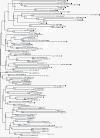Genotypic prediction of HIV-1 subtype D tropism
- PMID: 21752271
- PMCID: PMC3146927
- DOI: 10.1186/1742-4690-8-56
Genotypic prediction of HIV-1 subtype D tropism
Abstract
Background: HIV-1 subtype D infections have been associated with rapid disease progression and phenotypic assays have shown that CXCR4-using viruses are very prevalent. Recent studies indicate that the genotypic algorithms used routinely to assess HIV-1 tropism may lack accuracy for non-B subtypes. Little is known about the genotypic determinants of HIV-1 subtype D tropism.
Results: We determined the HIV-1 coreceptor usage for 32 patients infected with subtype D by both a recombinant virus phenotypic entry assay and V3-loop sequencing to determine the correlation between them. The sensitivity of the Geno2pheno10 genotypic algorithm was 75% and that of the combined 11/25 and net charge rule was 100% for predicting subtype D CXCR4 usage, but their specificities were poor (54% and 68%). We have identified subtype D determinants in the V3 region associated with CXCR4 use and built a new simple genotypic rule for optimizing the genotypic prediction of HIV-1 subtype D tropism. We validated this algorithm using an independent GenBank data set of 67 subtype D V3 sequences of viruses of known phenotype. The subtype D genotypic algorithm was 68% sensitive and 95% specific for predicting X4 viruses in this data set, approaching the performance of genotypic prediction of HIV-1 subtype B tropism.
Conclusion: The genotypic determinants of HIV-1 subtype D coreceptor usage are slightly different from those for subtype B viruses. Genotypic predictions based on a subtype D-specific algorithm appear to be preferable for characterizing coreceptor usage in epidemiological and pathophysiological studies.
Figures



References
-
- Dorr P, Westby M, Dobbs S, Griffin P, Irvine B, Macartney M, Mori J, Rickett G, Smith-Burchnell C, Napier C. et al.Maraviroc (UK-427,857), a potent, orally bioavailable, and selective small-molecule inhibitor of chemokine receptor CCR5 with broad-spectrum anti-human immunodeficiency virus type 1 activity. Antimicrob Agents Chemother. 2005;49:4721–4732. doi: 10.1128/AAC.49.11.4721-4732.2005. - DOI - PMC - PubMed
-
- Raymond S, Delobel P, Mavigner M, Cazabat M, Souyris C, Encinas S, Bruel P, Sandres-Saune K, Marchou B, Massip P, Izopet J. Development and performance of a new recombinant virus phenotypic entry assay to determine HIV-1 coreceptor usage. J Clin Virol. 2010;47:126–130. doi: 10.1016/j.jcv.2009.11.018. - DOI - PubMed
-
- Trouplin V, Salvatori F, Cappello F, Obry V, Brelot A, Heveker N, Alizon M, Scarlatti G, Clavel F, Mammano F. Determination of coreceptor usage of human immunodeficiency virus type 1 from patient plasma samples by using a recombinant phenotypic assay. J Virol. 2001;75:251–259. doi: 10.1128/JVI.75.1.251-259.2001. - DOI - PMC - PubMed
-
- Whitcomb JM, Huang W, Fransen S, Limoli K, Toma J, Wrin T, Chappey C, Kiss LD, Paxinos EE, Petropoulos CJ. Development and characterization of a novel single-cycle recombinant-virus assay to determine human immunodeficiency virus type 1 coreceptor tropism. Antimicrob Agents Chemother. 2007;51:566–575. doi: 10.1128/AAC.00853-06. - DOI - PMC - PubMed
Publication types
MeSH terms
Substances
Associated data
- Actions
- Actions
- Actions
- Actions
- Actions
- Actions
- Actions
- Actions
- Actions
- Actions
- Actions
- Actions
- Actions
- Actions
- Actions
- Actions
- Actions
- Actions
- Actions
- Actions
- Actions
- Actions
- Actions
- Actions
- Actions
- Actions
LinkOut - more resources
Full Text Sources
Medical

